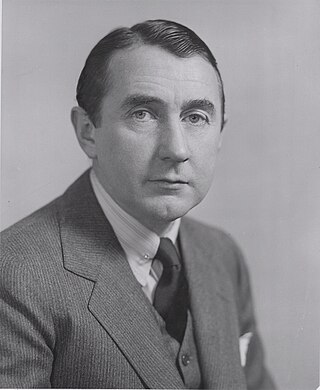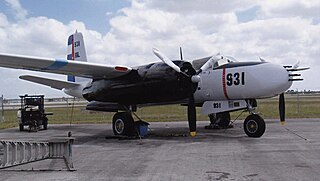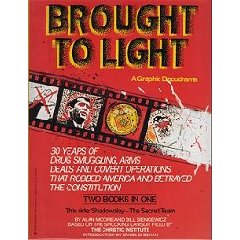CIA cryptonyms are code names or code words used by the U.S. Central Intelligence Agency (CIA) to refer to projects, operations, persons, agencies, etc.

Everette Howard Hunt Jr. was an American intelligence officer and author. From 1949 to 1970, Hunt served as an officer in the Central Intelligence Agency (CIA), where he was a central figure in U.S. regime change in Latin America including the 1954 Guatemalan coup d'état and the 1961 Bay of Pigs Invasion in Cuba. Along with G. Gordon Liddy, Frank Sturgis, and others, Hunt was one of the Nixon administration's so-called White House Plumbers, a team of operatives charged with identifying government leaks to outside parties.

The director of central intelligence (DCI) was the head of the American Central Intelligence Agency from 1946 to 2004, acting as the principal intelligence advisor to the president of the United States and the United States National Security Council, as well as the coordinator of intelligence activities among and between the various US intelligence agencies.
W. Thomas Smith Jr. is an American author, editor, and journalist. He has written several books. His articles have appeared in many newspapers and magazines. Smith is executive editor of World Defense Review, a columnist with Townhall.com, and a former contributor to National Review Online.

William Harding Jackson was a U.S. civilian administrator, New York lawyer, and investment banker who served as Deputy Director of the Central Intelligence Agency. Jackson also served briefly under President Dwight D. Eisenhower as Acting United States National Security Advisor from 1956 to 1957.

A black operation or black ops is a covert or clandestine operation by a government agency, a military unit or a paramilitary organization; it can include activities by private companies or groups. Key features of a black operation are that it is secret and it is not attributable to the organization carrying it out.

Publishers Weekly (PW) is an American weekly trade news magazine targeted at publishers, librarians, booksellers, and literary agents. Published continuously since 1872, it has carried the tagline, "The International News Magazine of Book Publishing and Bookselling". With 51 issues a year, the emphasis today is on book reviews.

Project FUBELT is the codename for the secret Central Intelligence Agency operations that were to prevent Salvador Allende's rise to power before his confirmation and to promote a military coup in Chile. This project came after the circumstantial failure of Track I, which involved making president Eduardo Frei Montalva interfere with the 1970 national election in opposition to Allende.

Brought to Light - subtitled Thirty Years of Drug Smuggling, Arms Deals, and Covert Action - is an anthology of two political graphic novels, published originally by Eclipse Comics in 1988.

Evan Welling Thomas III is an American journalist, historian, lawyer, and author. He is the author of 11 books, including two New York Times bestsellers.
Desmond FitzGerald was an American intelligence officer for the Central Intelligence Agency (CIA), where he rose to the position of Deputy Director of Plans. He served in the CIA from 1950 until his death. Posthumously he was awarded the National Security Medal. An attorney, he had worked in New York City both before and after World War II. During the war, he was an Army officer, serving as liaison and adviser to the Chinese Army.
Operation 40 was the code name for a Central Intelligence Agency-sponsored counterintelligence group composed of Cuban exiles. The group was formed to seize control of the Cuban government after the Bay of Pigs Invasion. Operation 40 continued to operate unofficially until disbanded in 1970 due to allegations that an aircraft that was carrying cocaine and heroin in support of the group crashed in California.
Executive oversight of United States covert operations has been carried out by a series of sub-committees of the National Security Council (NSC).
Kenneth C. Bucchi was a captain in the US Air Force for six years. He fought in the Gulf War and worked four years as both a private and undercover corporate investigator. He has authored books on his experiences and holds a B.S. in Criminology and Political Science from Murray State University.

Mission: Earth, Voyage to the Home Planet is a children's literature book by science writer June A. English and astronaut Thomas David Jones that was published in 1996 by Scholastic. Jones was among the crew members of the Space Shuttle Endeavour during an eleven-day mission in space, which was launched in April 1994 to study the ecological well-being of Earth using specialized radar technology. The book, which is illustrated with radar images and picturesque photographs, chronicles the mission and Jones' experiences of it.

Rufus Lackland Taylor Jr. was an officer in the United States Navy. Eventually he became Director of the Office of Naval Intelligence and held the rank of Vice Admiral. In 1966 he was appointed as Deputy Director of the Defense Intelligence Agency (DIA), then shortly thereafter as Deputy Director of the CIA, where he served from 1966 to 1969.

Acid Dreams: The Complete Social History of LSD: the CIA, the Sixties, and Beyond, originally released as Acid Dreams: The CIA, LSD, and the Sixties Rebellion, is a 1985 book by Martin A. Lee and Bruce Shlain, in which the authors document the 40-year social history of lysergic acid diethylamide (LSD), beginning with its synthesis by Albert Hofmann of Sandoz Pharmaceuticals in 1938. During the Cold War period of the early 1950s, LSD was tested as an experimental truth drug for interrogation by the United States intelligence and military community. Psychiatrists also used it to treat depression and schizophrenia. Under the direction of Sidney Gottlieb, the drug was used by the Central Intelligence Agency (CIA) in cooperation with participating "colleges, universities, research foundations, hospitals, clinics, and penal institutions". LSD was tested on "prisoners, mental patients, volunteers, and unsuspecting human subjects".

The Secret Man: An American Warrior's Uncensored Story is a memoir by martial artist Frank Dux, published in 1996 by ReganBooks. In the book, Dux asserts he was recruited by Central Intelligence Agency (CIA) director William J. Casey in a public toilet to work on covert missions, including destroying a fuel depot in Nicaragua and a chemical weapons plant in Iraq. Dux's claims in the book have been contested by several notable figures, including CIA director Robert Gates, General Norman Schwarzkopf Jr., Major General John K. Singlaub, as well as Soldier of Fortune magazine.
The Invisible Government is a 1964 non-fiction book by David Wise and Thomas B. Ross, published by Random House. The book described the operations and activities of the Central Intelligence Agency (CIA) at the time.

The Unexpected Spy: From the CIA to the FBI, My Secret Life Taking Down Some of the World's Most Notorious Terrorists is a 2019 memoir by Tracy Walder about her work in the Central Intelligence Agency (CIA) and the Federal Bureau of Investigation (FBI). Jessica Anya Blau assisted with the book, and it was published by St. Martin's Press.













